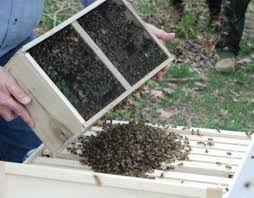Installing A Package into a Beehive

Installing Your Bees Into Your BeeHive
You’ve built your bee hive, and have picked out the brood of bees to take up residence in it. Now is the fun part—adding your bees to your beehive. The most crucial thing to remember during this part of the process is that you be patient, take your time, and above all, enjoy the experience. You will be surprised just how cooperative and docile your bees will be when you being acclimating them to their new home.
It is best to read all of the steps, maybe several times, and make sure that you feel comfortable with each part of the process. It would be great if you tried a couple of dry runs, just to be sure of what the process will entail so that when your bees arrive, you will be good to go!
Experts suggest that it is best to introduce your bees to their new beehive, late in the afternoon on the day that they arrive to you. If you need to wait until the next afternoon, that is okay. Just make sure that the day you choose to house them is a mild one, with little to no wind. If it is rainy and cold, it is best to wait.
Now comes the fun part. Keep in mind that when you introduce your bees to the new beehive, you will need to make sure to follow the steps below in the order they are given so that you will achieve the best outcome.
• Approximately thirty minutes before you actually plan to place your bees into the beehive, you will need to rather heavily spray the entire brood with a non-medicated sugar syrup. Be careful that you don't drown them in the syrup. It will suffice to use common sense in this step, as your bees with be fine.
•
• Now, taking a hive tool, you will need to pry the wood cover off the top of the package that your bees were shipped in. At this point, you will need to pull any nails or staples that are in the cover and then set that cover aside. You will be using this later.
•
• Tap or jar the container down sharply so that your bees are forced to the bottom of the package. Do not worry, as this process will not hurt them. Once they are all at the bottom, you will then remove the enclosed jar of syrup as well as the included queen cage. This is where the original package cover comes back into play, as you will place it back on the package.
•
• In this step, you are going to evaluate the health and well being of your queen bee. Examine the queen cage—are you able to see your queen and her accompanying attendants? Does she appear healthy and okay? In some rare cases, the queen will perish during transit. If this is the case for you, not to worry, as you may go ahead with the housing of your bees as usual. However, make sure to call the company that sold you your bees, and let them know you need a replacement queen (usually at no charge). Your colony should be fine for the amount of time it will take for you to be sent your replacement queen.
•
• On your queen cage, you will see a metal disc. You will need to slide this disc slowly to the side. Remove the cork that is present at one end of the queen cage, and peer inside to see if you can see the hole with the white candy. If you can visualize the candy, then you can now remove the disc entirely at this time. If you find that the candy seems to be missing, just take a small piece of marshmallow and use it to plug the hole.
•
• Take two small framing nails, and bend them both at right angles. You will use these to fashion the queen cage its own hanging bracket.
•
• You will now spray your bees, and once again tap and jar the package so that the bees drop to the bottom. Again, use common sense with the syrup spray, and do not worry, the jarring will not hurt or damage your bees.
• Remove five frames from your hive, but make sure to keep them handy and within reach. It is crucial to remember that at this point in the process, you are only working with the lower, deep body of your hive. You will now need to hang the queen cage (candy side up) between your centermost hive frame and the next frame that faces towards the center. Please remember, the screen side of the caging needs to be facing toward the center of the hive.
•
• You will now spray your bees heavily one last time. Tap and jar your bees down, and removed the wood cover on the package. Shake and pour approximately one-half of your bees directly above where the queen cage is hanging. Then with the remainder of your bees, shake or pour them into the open area that was left vacant by the removal of the previous five frames.
•
• Give the bees a few moments to adjust to their new surroundings and disperse a little. You will then replace four of the five frames back into the hive. Make sure this step is done in a gingerly fashion, so as not to crush or damage your bees. If you find the bees are not dispersing, and are congregating in somewhat of a pile, take your gloved hand and gently encourage them to disperse.
•
• In the use of a hive-top feeder, the inner cover is now placed and should be in direct contact with the bees. If you are not using an inner cover, skip to the next step in the process. The use of the inner cover is only needed when the hive is being fed by way of a jar or a pail. The outer cover is then placed on the hive-top feeder.
•
• For hive-top feeding invert a feeding pail, approximately one quart in size, over the inner covers oval hole. You will then need to add a second, deep super on the inner cover. Make sure to insulate the cavity around the jar with newspaper.
• If your inner cover has a half-moon ventilation notch, you will need to cover it with a clump of grass. Please note that some inner covers do not have a ventilation notch. The reason for the covering of the notch is to keep the bees in the hive until they have established it as their new home.
•
• You are almost done! You will now place the outer cover on the hive top.
• The entrance reducer will now be inserted. Make sure to leave a one-finger opening as this is the best size for your bees to defend the beehive at this point. Until the bees have successfully built up their numbers, keep this opening small is the best choice. Once your colony has grown, they will be better able to defend the entrance against any and all intruders. It usually takes four weeks for their numbers to reach the amount necessary for a proper defense.
• And there you have it! Your step by step guide to adding your bees to your beehive. Make sure to check out our website at Petric Bees for all your beekeeping equipment. We even sell the bees to populate your new beehives! Check out some of our great products at https://petricbees.com/sale for the many options on how you can get started in beekeeping.
